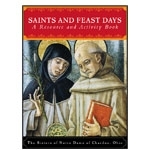Saint John of Damascene (late 600s-mid 700s)
Feast Day December 4

John grew up in the rich, luxurious court of the Muslim ruler of Damascus, where his father was a wealthy Christian court official. In order to make sure John had a solid Christian foundation, his father employed a brilliant Sicilian monk named Cosmos, who was a war captive, to teach John. Cosmos schooled the boy in science and theology, in the Greek and Arabic languages, and in the culture of Islam. Then John was ready to assume a high place in the government, which he did. But the spirit of the Muslim rulers was turning against Christians, so John left his position in the government and became a monk in Jerusalem. The date of his death is uncertain. Some think he may have lived to be 104 years old.

We know about John’s faith through his writings. In them John explained the mysteries of the Christian faith, such as the Trinity, the Incarnation, the Real Presence in the Eucharist, and Mary’s Assumption. One book he wrote is an important source on the teachings of the Greek Fathers of the Church. John was also a poet and hymn writer. Some of his songs are summaries of the truths of faith.
Perhaps John is most famous for his opposition to the heresy of the Iconoclasts. The Iconoclasts claimed that is superstitious to have religious images. They wanted to destroy all religious icons, pictures, and statues. The Iconoclasts were supported by the Eastern Christian Emperor Leo III. John of Damascene defended the use of sacred images. He explained that the respect given to them is really given to the person they represent. If you look around an Orthodox Church today, you will see that John won the debate. For all of his efforts to defend the faith, John of Damascene was named a Doctor of the Church in 1890.

from Saints and Feast Days, by Sisters of Notre Dame of Chardon, Ohio
Image credit: John of Damascus by Ne'meh naser Homsi, 19th century. Public Domain via Wikimedia.

